While a proposed redevelopment of the Richmond Coliseum and adjacent downtown area has dominated headlines in recent years, city leaders appear to be turning their attention back to another big-ticket project that had been put on the back-burner: redevelopment of The Diamond and surrounding city-owned land.
The 60-acre site along Arthur Ashe Boulevard is being given renewed emphasis in an in-the-works update to Richmond’s comprehensive plan, a master-planning initiative called Richmond 300. The years-long effort includes a redevelopment study of what city planners are referring to as “Greater Scott’s Addition,” an area that includes the baseball stadium site and other city-controlled properties.

Map of Richmond 300’s “Greater Scott’s Addition” study area, with city-owned properties shown in green. Click to enlarge. (Courtesy Richmond 300.com)
The draft document, taking shape with community input from surveys and public meetings, articulates “the opportunity for redevelopment” of the Boulevard site and surrounding area, with presentations noting past efforts to redevelop the Diamond site specifically.
During one such presentation last week, at a meeting of the advisory council overseeing Richmond 300, council Chairman Rodney Poole posed a question that he said he’s been hearing lately and has heard off and on for months: whether the city is going to put out a request for proposal for development of the 60 acres.
“I’d really like to have an answer to that question,” said Poole, a senior vice president with local development firm The Wilton Cos. who also chairs the Richmond Planning Commission.
Presenters replied that the question would be best answered by city planning director Mark Olinger, who is leading the Richmond 300 effort but wasn’t present for the meeting. Project manager Maritza Pechin, with Richmond 300 consulting firm AECOM, responded that the site and surrounding area are integral to the larger planning effort, and to Richmond’s overall economic development potential.
“We’ve talked about other areas in the city that need some development, but this one is a prime 60 acres that developers all around the country are looking at,” Poole said at the meeting. “I think we should direct that as best as we can.”
Talk around town
Asked after the meeting what prompted his question, Poole said he’s been hearing talk of late about an RFP potentially in the works, though he acknowledged that he’s heard similar chatter every six or so months in the past year. He said interest in the site from developers up and down the East Coast is further fueling speculation.
City Council member Kim Gray, whose district includes The Diamond, likewise acknowledged recent chatter about a pending RFP, though she described the talk as “only rumors” at this point.
Over the weekend, Stoney said on Roben Farzad’s “Full Disclosure” radio show that the city is going to put the Boulevard site out to developers “in the future.”
The project is not among RFPs listed on an online notice board for the city’s procurement services department.
Jim Nolan, a spokesman for Mayor Levar Stoney’s office, said the “Greater Scott’s Addition” study underway as part of Richmond 300 would “form the basis for a future RFP” for the site, though he didn’t say when an RFP could be issued. He said a timetable for an RFP was not provided to him in response to an inquiry from BizSense.
Reached this week, Olinger, the city planning director, reiterated that the Boulevard-area study would help shape the master plan, which in turn would inform an eventual RFP.
“One of the things that we have talked about as it relates to Greater Scott’s Addition is being a little more purposeful about laying out” the city’s vision for the area, Olinger said.
“Instead of just throwing it out there saying we’re at the off ramp of 95 and Arthur Ashe and we have the 60 acres and what’s going on around it, make a little more of an affirmative statement about a framework that we’d like to see what happens within those 60 acres as a part of what happens around it.”
Fits and starts
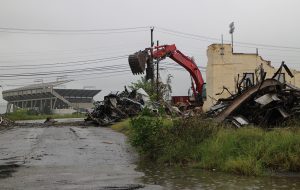
Demolition took place near The Diamond in 2016, when the city was fielding RFQs from developers. (BizSense file photo)
The city’s last push to market the Diamond site for development was in 2016, when then-Mayor Dwight Jones’ administration issued a request for qualifications from developers in its search for the property’s “highest and best use.”
The RFQ process typically precedes an RFP, but while the city received responses from different development firms, it never went forward with a formal proposal request.
Jane Ferrara, who oversaw the RFQ for the city’s economic development department, noted the process played out just before Stoney’s election in late 2016. Ferrara, who left the city last week after more than 14 years with the department, said beforehand that the process essentially fizzled out in the transition from Jones’ administration to Stoney’s.
“The same thing happened when Wilder left,” Ferrara said, referring to former Mayor Doug Wilder, Jones’s predecessor. “They did an RFP, and a developer was actually selected, and then Dwight Jones came in and decided he wanted to have his own vision for that property, so that was cancelled.”
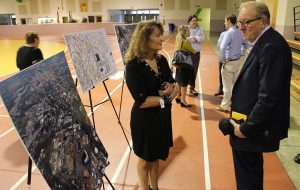
Jane Ferrara of the city’s economic and community development department speaking with developers in 2016. (BizSense file photo)
Jones championed a push to free up the Diamond site by relocating Richmond baseball to Shockoe Bottom, via a stadium-anchored mixed-use development that never materialized. Talk turned to keeping baseball on the Boulevard, with suggestions ranging from building a new stadium in the vicinity, to keeping The Diamond where it is with mixed-use development worked in around it.
Since Stoney’s election, proposals have included the site’s pitch in 2017 as a potential location to land Amazon’s HQ2. Attention also has turned toward the adjacent Virginia ABC site, which will be freed up when the state agency relocates its headquarters to Hanover County.
Most recently, VCU has shown interest in developing an athletics facility there that could include a new stadium it could share with the Richmond Flying Squirrels, the local minor league team that currently shares The Diamond with VCU Baseball.
While such plans hinge on ABC’s move, targeted for spring 2021 as of last May, they would not determine what is to come with The Diamond site, which is what Olinger and Ferrara said is an end goal for the Richmond 300 plan.
Ferrara said the study currently underway likely would lead to a so-called Small Area Plan for the Boulevard and Scott’s Addition areas. That plan then would be worked into the master plan, with public input throughout the process via meetings and surveys. A recent survey gauging public opinions on desired uses in the area closed over the weekend and received over 1,000 responses, Olinger said.
“Our goal is to have whatever comes out of this process fit into Richmond 300, and our intent is that it would help inform an RFP for the area,” Olinger said.
Developers ready
At last week’s advisory council meeting, Poole said afterward that developers are frustrated with the apparent lack of movement on The Diamond site, which was the topic of a panel discussion hosted by BizSense last year that included Stoney, Gray and Andrew Basham of local development firm Spy Rock Real Estate.
Poole cited Spy Rock among local firms that have expressed interest. Another is Rebkee, which pitched a plan for the site during the Jones administration and was among those that responded to the 2016 RFQ. Rebkee principal Rob Hargett said the firm worked on its proposal with Thalhimer Realty Partners, which recently dropped $3.7 million to pick up the nearby Wesco Distribution site, directly across the Boulevard from The Diamond.
“The city put out an RFQ, we answered it, they never responded,” Hargett said, describing the group’s plans for the site as comparable to the Virginia Beach Town Center development. Hargett said tenants they had lined up included Topgolf, which ended up taking a site on Westwood Avenue in Henrico County instead.
Hargett said his firm, which developed the nearby Cookie Factory Lofts, would respond again if an RFP for the Diamond site is issued.
“We’re still interested,” Hargett said. “We’ve got the Cookie Factory over there still. We want to keep doing stuff in the city. We moved our offices into the city; we’re here on the Boulevard now.
“I’m sure we’d try to do something. It’s a great piece of dirt.”
While a proposed redevelopment of the Richmond Coliseum and adjacent downtown area has dominated headlines in recent years, city leaders appear to be turning their attention back to another big-ticket project that had been put on the back-burner: redevelopment of The Diamond and surrounding city-owned land.
The 60-acre site along Arthur Ashe Boulevard is being given renewed emphasis in an in-the-works update to Richmond’s comprehensive plan, a master-planning initiative called Richmond 300. The years-long effort includes a redevelopment study of what city planners are referring to as “Greater Scott’s Addition,” an area that includes the baseball stadium site and other city-controlled properties.

Map of Richmond 300’s “Greater Scott’s Addition” study area, with city-owned properties shown in green. Click to enlarge. (Courtesy Richmond 300.com)
The draft document, taking shape with community input from surveys and public meetings, articulates “the opportunity for redevelopment” of the Boulevard site and surrounding area, with presentations noting past efforts to redevelop the Diamond site specifically.
During one such presentation last week, at a meeting of the advisory council overseeing Richmond 300, council Chairman Rodney Poole posed a question that he said he’s been hearing lately and has heard off and on for months: whether the city is going to put out a request for proposal for development of the 60 acres.
“I’d really like to have an answer to that question,” said Poole, a senior vice president with local development firm The Wilton Cos. who also chairs the Richmond Planning Commission.
Presenters replied that the question would be best answered by city planning director Mark Olinger, who is leading the Richmond 300 effort but wasn’t present for the meeting. Project manager Maritza Pechin, with Richmond 300 consulting firm AECOM, responded that the site and surrounding area are integral to the larger planning effort, and to Richmond’s overall economic development potential.
“We’ve talked about other areas in the city that need some development, but this one is a prime 60 acres that developers all around the country are looking at,” Poole said at the meeting. “I think we should direct that as best as we can.”
Talk around town
Asked after the meeting what prompted his question, Poole said he’s been hearing talk of late about an RFP potentially in the works, though he acknowledged that he’s heard similar chatter every six or so months in the past year. He said interest in the site from developers up and down the East Coast is further fueling speculation.
City Council member Kim Gray, whose district includes The Diamond, likewise acknowledged recent chatter about a pending RFP, though she described the talk as “only rumors” at this point.
Over the weekend, Stoney said on Roben Farzad’s “Full Disclosure” radio show that the city is going to put the Boulevard site out to developers “in the future.”
The project is not among RFPs listed on an online notice board for the city’s procurement services department.
Jim Nolan, a spokesman for Mayor Levar Stoney’s office, said the “Greater Scott’s Addition” study underway as part of Richmond 300 would “form the basis for a future RFP” for the site, though he didn’t say when an RFP could be issued. He said a timetable for an RFP was not provided to him in response to an inquiry from BizSense.
Reached this week, Olinger, the city planning director, reiterated that the Boulevard-area study would help shape the master plan, which in turn would inform an eventual RFP.
“One of the things that we have talked about as it relates to Greater Scott’s Addition is being a little more purposeful about laying out” the city’s vision for the area, Olinger said.
“Instead of just throwing it out there saying we’re at the off ramp of 95 and Arthur Ashe and we have the 60 acres and what’s going on around it, make a little more of an affirmative statement about a framework that we’d like to see what happens within those 60 acres as a part of what happens around it.”
Fits and starts

Demolition took place near The Diamond in 2016, when the city was fielding RFQs from developers. (BizSense file photo)
The city’s last push to market the Diamond site for development was in 2016, when then-Mayor Dwight Jones’ administration issued a request for qualifications from developers in its search for the property’s “highest and best use.”
The RFQ process typically precedes an RFP, but while the city received responses from different development firms, it never went forward with a formal proposal request.
Jane Ferrara, who oversaw the RFQ for the city’s economic development department, noted the process played out just before Stoney’s election in late 2016. Ferrara, who left the city last week after more than 14 years with the department, said beforehand that the process essentially fizzled out in the transition from Jones’ administration to Stoney’s.
“The same thing happened when Wilder left,” Ferrara said, referring to former Mayor Doug Wilder, Jones’s predecessor. “They did an RFP, and a developer was actually selected, and then Dwight Jones came in and decided he wanted to have his own vision for that property, so that was cancelled.”

Jane Ferrara of the city’s economic and community development department speaking with developers in 2016. (BizSense file photo)
Jones championed a push to free up the Diamond site by relocating Richmond baseball to Shockoe Bottom, via a stadium-anchored mixed-use development that never materialized. Talk turned to keeping baseball on the Boulevard, with suggestions ranging from building a new stadium in the vicinity, to keeping The Diamond where it is with mixed-use development worked in around it.
Since Stoney’s election, proposals have included the site’s pitch in 2017 as a potential location to land Amazon’s HQ2. Attention also has turned toward the adjacent Virginia ABC site, which will be freed up when the state agency relocates its headquarters to Hanover County.
Most recently, VCU has shown interest in developing an athletics facility there that could include a new stadium it could share with the Richmond Flying Squirrels, the local minor league team that currently shares The Diamond with VCU Baseball.
While such plans hinge on ABC’s move, targeted for spring 2021 as of last May, they would not determine what is to come with The Diamond site, which is what Olinger and Ferrara said is an end goal for the Richmond 300 plan.
Ferrara said the study currently underway likely would lead to a so-called Small Area Plan for the Boulevard and Scott’s Addition areas. That plan then would be worked into the master plan, with public input throughout the process via meetings and surveys. A recent survey gauging public opinions on desired uses in the area closed over the weekend and received over 1,000 responses, Olinger said.
“Our goal is to have whatever comes out of this process fit into Richmond 300, and our intent is that it would help inform an RFP for the area,” Olinger said.
Developers ready
At last week’s advisory council meeting, Poole said afterward that developers are frustrated with the apparent lack of movement on The Diamond site, which was the topic of a panel discussion hosted by BizSense last year that included Stoney, Gray and Andrew Basham of local development firm Spy Rock Real Estate.
Poole cited Spy Rock among local firms that have expressed interest. Another is Rebkee, which pitched a plan for the site during the Jones administration and was among those that responded to the 2016 RFQ. Rebkee principal Rob Hargett said the firm worked on its proposal with Thalhimer Realty Partners, which recently dropped $3.7 million to pick up the nearby Wesco Distribution site, directly across the Boulevard from The Diamond.
“The city put out an RFQ, we answered it, they never responded,” Hargett said, describing the group’s plans for the site as comparable to the Virginia Beach Town Center development. Hargett said tenants they had lined up included Topgolf, which ended up taking a site on Westwood Avenue in Henrico County instead.
Hargett said his firm, which developed the nearby Cookie Factory Lofts, would respond again if an RFP for the Diamond site is issued.
“We’re still interested,” Hargett said. “We’ve got the Cookie Factory over there still. We want to keep doing stuff in the city. We moved our offices into the city; we’re here on the Boulevard now.
“I’m sure we’d try to do something. It’s a great piece of dirt.”

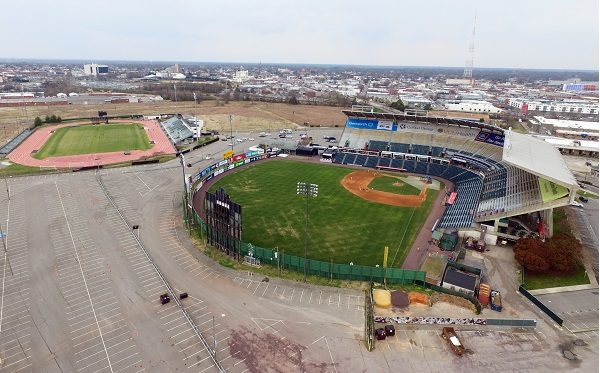
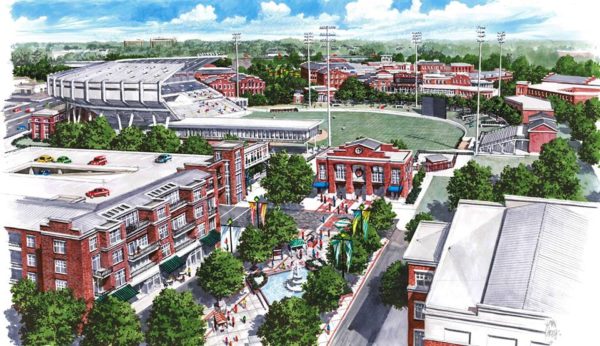
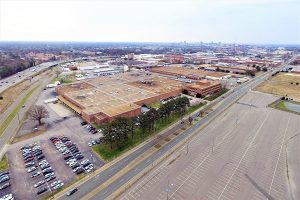



It would be nice to see something happen there. It’s the gateway to Richmond.
And in typical city fashion, the city is going to mess around and waste another 10 years, even though we are pretty close to top of the business cycle.
The redevelopment of Scott’s Addition into a residential and entertainment district with seven story apartment buildings has dated the schematics for the 60 acres. Those proposals are now seen as short sighted. I hope someone is reviewing access to that area by now. The ingress/egress at I-95 at the stoplight is completely inadequate at todays standards. Just think what that interchange backup will be in ten years.
If we are thinking ten years ahead, how might this area look as a low / no traffic development? Thinking that today’s standards involves increased vehicular traffic will only see Richmond perpetuating today’s problems for decades. The city has the beginnings of a solid public transit system. Let’s see some vision and work on life in the city not being based around the car.
Whatever the plan is, I hope the developers are forward looking enough to include age in place accommodations for the growing number of adults who want to own a one level living arrangement in town near public transport and services. The deluge of rentals and cheaply constructed townhomes won’t appeal to the gen xers now in their 50s who are approaching empty nesting.
Take a page from Portland, OR and look to mixed use, energy efficient development with heat recapture and solar. If we can think past the quick buck, the city will continue to thrive for many more years.
That’s a great idea. We’ve been pushing for more energy efficient development in RVA for years now. With the widespread adoption of IECC 2018 maybe the time has come!
Nice job on such a comprehensive story, revisiting an issue of interest to our community.
Town Center, come on, no way anything as big as that is coming as we do not need (nor is there demand) for a new performing arts center, a 40 floor hotel, two or three 15-20 story office buildings, apartments/condos and all that retail and restaurant. Town Center was built to give VA Beach what is was always lacking as a city; a central business district. RVA has a downtown. I could see this on the size and scale of the Domain development in Austin but not anywhere as high end retail/hotel. Instead of Nordstrom and Macys and Dillards it… Read more »
VCU has the ” Right of First Refusal ” on the existing ABC headquarters. Until a decision is made there nothing will happen. The best option for the relocation of The Diamond is still where the former city maintenance facility was located. It would fit like a “glove.”It would be tight to the railroad tracks to the south, with Sports backers Stadium ( partially owned by VCU) to the east, and Arthur Ashe Boulevard to the west. It would have the same orientation as The Diamond. Oneok Field, home of the Tulsa Drillers, a AA baseball team, and FC Tulsa,… Read more »